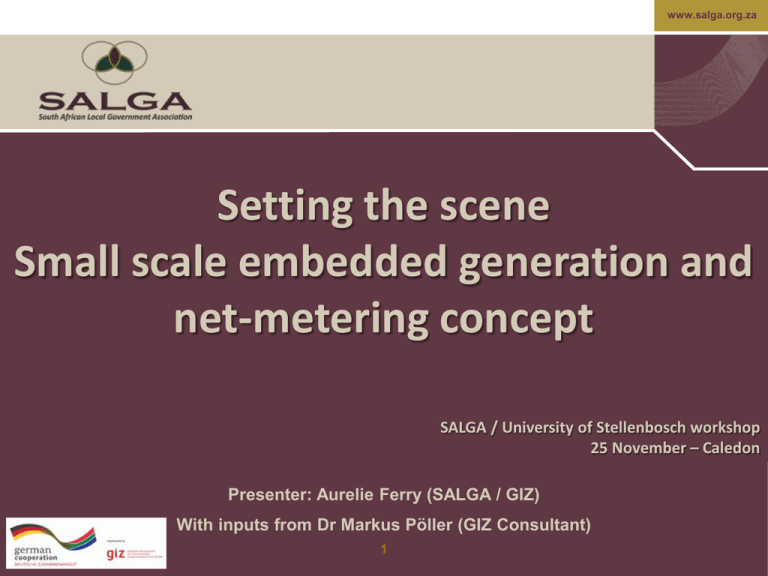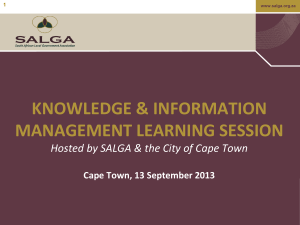Setting the scene Small scale embedded generation and net-metering concept
advertisement

www.salga.org.za Setting the scene Small scale embedded generation and net-metering concept SALGA / University of Stellenbosch workshop 25 November – Caledon Presenter: Aurelie Ferry (SALGA / GIZ) With inputs from Dr Markus Pöller (GIZ Consultant) 1 www.salga.org.za OVERVIEW AND CONCEPT 2 www.salga.org.za Overview Generation (e.g. solar PV*) Imported electricity @ import tariff Consumer (residential, Meter commercial or industrial) Municipal Grid used as storage Exported electricity @ export tariff 2. Excess is feed back to the grid * Embedded generation may also come from other sources of energy such as wind, biogas. Etc. 1. Own consumption www.salga.org.za Process to date 2008 / 2010: 1 Several municipalities (CCT, NMBM) enquire about embedded generation September 2011: 2 NERSA present a Decision Paper relating to Small Scale Embedded Generation within Municipal Boundaries (less than 100kW) 2012 / 2013: several AMEU / SALGA / ESKOM / GIZ workshops to discuss comments (support of expert financed by GIZ) • Information sent to all AMEU members at different stages of the process • 13 municipalities (7 metros) actively participated 3 May 2014: consensus reached on net-metering concept. 4 final draft available and sent to all municipalities for comments via circular Nb 14/2014 5 July 2014: Concept approved by SALGA NEC and submitted to NERSA 2015 ? www.salga.org.za Purpose and scope of the scheme • Avoid illegal connections => Sufficient incentive (export tariff) • Encourage uptake => Low administrative overhead => Security of investments (guaranteed tariff or concept) => Low overhead costs for additional equipment, such as meters etc. • Limit impact on municipal revenue: => Export tariff that is sufficiently low => Fair coverage of costs of grid usage • Decrease peak consumption => Tariff that provides an incentive for timely use of electricity www.salga.org.za Definition of net-metering • A net-metering client: • Can export and import electricity • Is still considered to be a consumer and not a generator • Tariffs for export and import can either: • be the same (“classical net-metering”, e.g. USA) or • different (example: Philippines, Germany). • Over a billing cycle (e.g. one year) the remuneration of exported electricity is capped to the value of imported electricity (no net payment possible). www.salga.org.za THE PROPOSAL TO NERSA 7 www.salga.org.za Proposal – Net metering / net billing scheme (1/3) 1. Maximum size: 100 kW / LV (while recommending to extend it to 1MW) 2. Applicable to both ESKOM and municipalities’ customers 3. No licenses required 4. Net-metering customers are netconsumers and not net-generators 5. Metering using two single-directional meters or one bi-directional meter. No obligation to install Smart-Meters. www.salga.org.za Proposal – Net metering / net billing scheme (2/3) 6. Primarily for own consumption (with possible remuneration for net-electricity exchanged) 7. Individual tariffs for export and import 8. The tariffs to be determined individually by each municipality which will apply to NERSA for approval 9. Tariff scheme contains: • A fixed monthly rate based on installed kVA of customer • A set tariff for net-import of electricity or optionally a Time of Use (TOU) tariff. • A set tariff for net-export of electricity 10. The application of suitable Time-of-Use-Tariffs shall be possible but not be mandatory www.salga.org.za Proposal – Net metering / net billing scheme (3/3) 11. Obligation of the distribution utility (DU) to take the exported energy under normal operating conditions. 12. No obligation to the DU to give consent to any application for the connection of SSEG with immediate effect. However, applications shall not be rejected or withheld unreasonably and shall be subject to the capability of the DU’s network and resources (technical and financial). 13. Reference to NRS 097-2-3 or any other appropriate technical standard shall be included (for technical compliance and safety) www.salga.org.za CONCLUSION AND WAY FORWARD 11 www.salga.org.za Examples of existing schemes • City of Cape Town • Nelson Mandela Bay • eThekwini • Others? • Case study under development (ICLEI / GIZ / SALGA initiative) • How to learn from existing projects (copying and not reinventing) • More info on www.cityenergy.org.za www.salga.org.za GIZ Support Technical connection rules Incentive scheme / tariff Applications and approval Generation forecasting Quality of installations Support to individual municipalities … 13 www.salga.org.za Way Forward Have engaged discussions today to identify the way forward J www.salga.org.za Thank you Contact: Aurelie Ferry aferry@salga.org.za NMBM small scale embedded generation pilot project installed in 2008 – +27 (0)79 140 6698 copyright / photographer: D Liebenberg www.cityenergy.org.za 15 www.salga.org.za STILL UNDER DISCUSSION 16 www.salga.org.za Some questions Institutional Application process Could it be similar from one municipality to the other? Guaranteed stability for investors www.salga.org.za Some questions - Tariffs Export tariff below import tariff: Incentive for timely export of electricity (e.g. through storage, timely operation of heating systems etc.) Should not be too low because this would provide an incentive for illegal installation. Can be defined in-line with the usual purchase price of electricity of the distribution utility. Cost of grid usage: To limit impact on municipal revenue and to ensure that municipality gets paid for maintenance of the grid Need to understand the cost of supply / grid operation Too high costs of grid usage would endanger economic viability of most rooftop PV projects Import tariff (kWh) can be reduced correspondingly www.salga.org.za Some questions Technical Technical Rules for Interconnection of Net-Metering Systems: One document focusing on safe installation, safe operation and avoidance of negative impact on power quality. NRS 097-2-3 under development Standards (SANS) under development in parallel






